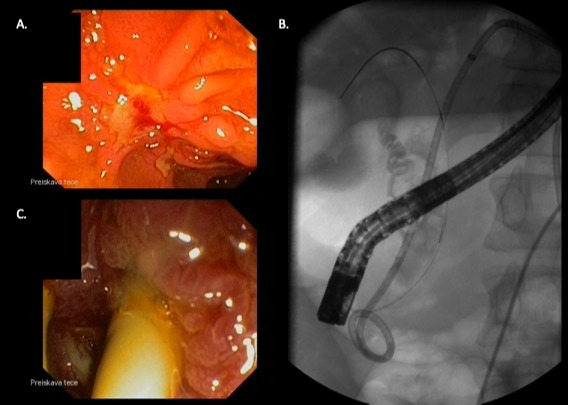Back


Poster Session B - Monday Morning
Category: Biliary/Pancreas
B0067 - Crohn’s Disease of Duodenum and Ampulla as Cause of Biliary Sepsis
Monday, October 24, 2022
10:00 AM – 12:00 PM ET
Location: Crown Ballroom

Has Audio

Sebastian Stefanovic, MD
Diagnostic Center Bled
Bled, Bled, Slovenia
Presenting Author(s)
Sebastian Stefanovic, MD1, David Drobne, MD, PhD2
1Diagnostic Center Bled, Bled, Bled, Slovenia; 2University Medical Center Ljubljana, Ljubljana, Ljubljana, Slovenia
Introduction: We present a case of a 25-year-old man with large and small bowel Crohn’s disease (CD) that was admitted for further evaluation of acute right upper quadrant pain, elevated liver function tests (AST 157 IU/L, ALT 184 IU/L, ALP 117 IU/L, Total bilirubin 1.58 mg/dL, GamaGT 267 IU/L, WBC 18.3 x 1000/uL) and fever. Blood cultures were positive for Klebsiella spp.
Case Description/Methods: He was recently switched from infliximab to adalimumab due to secondary treatment failure.
Magnetic resonance cholangiopancreatography showed choledocholithiasis with dilatated common bile duct (CBD) at 20 mm.
Endoscopic retrograde cholangiopancreatography (ERCP) failed due to extensive Crohn’s disease in the duodenum that caused ulceration with subsequent fibrosis of the ampulla (Panel A). An external-internal drainage was inserted with fluoroscopic guided percutaneous transhepatic biliary access (PTD).
Follow-up ERCP was performed with cannulation of the CBD beside the PTD catheter. Multiple stones were removed, and the PTD catheter was exchanged for biliary stent (Panel B and C). After discharge, he was scheduled for a repeat ERCP with stent exchange.
Discussion: CD of the duodenum is rare; it occurs in less than 5% of adult patients with CD. Manifestations of duodenal CD are nonspecific. While CBD obstruction as a complication of CD is reported in the literature, this is the first case that describes a fibrosis as a consequence of CD as cause of biliary sepsis. This case highlights a rare but important complication of duodenal CD. While pediatric guidelines recommend upper gastrointestinal endoscopy in all children with CD, the adult guidelines recommend it only be done in patients with upper gastrointestinal symptoms. Our case highlights the need for a case by case approach.

Disclosures:
Sebastian Stefanovic, MD1, David Drobne, MD, PhD2. B0067 - Crohn’s Disease of Duodenum and Ampulla as Cause of Biliary Sepsis, ACG 2022 Annual Scientific Meeting Abstracts. Charlotte, NC: American College of Gastroenterology.
1Diagnostic Center Bled, Bled, Bled, Slovenia; 2University Medical Center Ljubljana, Ljubljana, Ljubljana, Slovenia
Introduction: We present a case of a 25-year-old man with large and small bowel Crohn’s disease (CD) that was admitted for further evaluation of acute right upper quadrant pain, elevated liver function tests (AST 157 IU/L, ALT 184 IU/L, ALP 117 IU/L, Total bilirubin 1.58 mg/dL, GamaGT 267 IU/L, WBC 18.3 x 1000/uL) and fever. Blood cultures were positive for Klebsiella spp.
Case Description/Methods: He was recently switched from infliximab to adalimumab due to secondary treatment failure.
Magnetic resonance cholangiopancreatography showed choledocholithiasis with dilatated common bile duct (CBD) at 20 mm.
Endoscopic retrograde cholangiopancreatography (ERCP) failed due to extensive Crohn’s disease in the duodenum that caused ulceration with subsequent fibrosis of the ampulla (Panel A). An external-internal drainage was inserted with fluoroscopic guided percutaneous transhepatic biliary access (PTD).
Follow-up ERCP was performed with cannulation of the CBD beside the PTD catheter. Multiple stones were removed, and the PTD catheter was exchanged for biliary stent (Panel B and C). After discharge, he was scheduled for a repeat ERCP with stent exchange.
Discussion: CD of the duodenum is rare; it occurs in less than 5% of adult patients with CD. Manifestations of duodenal CD are nonspecific. While CBD obstruction as a complication of CD is reported in the literature, this is the first case that describes a fibrosis as a consequence of CD as cause of biliary sepsis. This case highlights a rare but important complication of duodenal CD. While pediatric guidelines recommend upper gastrointestinal endoscopy in all children with CD, the adult guidelines recommend it only be done in patients with upper gastrointestinal symptoms. Our case highlights the need for a case by case approach.

Figure: A) Crohn’s disease ulceration with subsequent fibrosis of the ampulla.
B) Fluoroscopic image of percutaneously placed biliary stents.
C) Endoscopic image of percutaneously placed biliary stents.
B) Fluoroscopic image of percutaneously placed biliary stents.
C) Endoscopic image of percutaneously placed biliary stents.
Disclosures:
Sebastian Stefanovic indicated no relevant financial relationships.
David Drobne indicated no relevant financial relationships.
Sebastian Stefanovic, MD1, David Drobne, MD, PhD2. B0067 - Crohn’s Disease of Duodenum and Ampulla as Cause of Biliary Sepsis, ACG 2022 Annual Scientific Meeting Abstracts. Charlotte, NC: American College of Gastroenterology.
